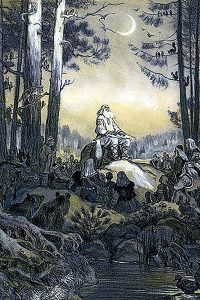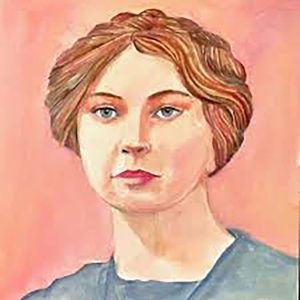The Norwegians and Dublin’s Christ Church
When we Irish set off on a holiday, or related pilgrimage (to repeat myself slightly from the other week), we inevitably turn south. Because of this we often miss many interesting things.
It seems our chilled Hyperborean hearts need a large supply of those “beaded bubbles winking at the rim” that the poet Keats romances over so glowingly in the poem we all learnt once at school. For us, it is south, always south.
The Northern lands of Scandinavia, by contrast, seem beyond us, even though there are the millennial-long connections with our land, some violent, of course, others involving more cultural, often spiritual matters. The notes and remarks this week emphasise not particular places, as in the previous articles, but general aspects of Scandinavian and Northern culture that have connections with Ireland or religion.
The Norse arrived as pagans, and the monastic annals and poetry of the eighth and later centuries are filled with disdain for these savages. I cannot be the only one to have carried away from those first years of Irish history at school the simple, and then attractive idea, that Brian Boru had driven all the Danes out of Ireland, leaving the vacant land behind for the enjoyment of the natives…yes well, not quite…

The Norse became Irish and the Irish became Norse. In due course they were converted with their Norse kinfolk in the North and scattered across the Atlantic as far as the Hiberno-Norse settlement in Vinland beyond the ocean.
Indeed, in the city of Dublin the first-ever Cathedral, Christ Church, was built by the Norse. I have long suspected that this fane, of which nothing now remains (having been built over by the later church), was actually built of wood in the manner of the medieval Scandinavian churches. It must have been a lovely sight, as some of those that still survive in Norway indeed are.
Those transoceanic colonies of the Norse planted among the natives of North America, by the way, as I have suggested, must have had over the centuries strong connections with Dublin, for they were a well-established source of salted fish, furs, ivory from walruses, and some slaves, of course, for the Dublin market.
Certainly the evidence shows that the people were still being visited by bishops up to the time they vanished from history, after 1450, though from that date no documents seem to survive, either relating to Ireland or Vinland in the Vatican Archives. But no one I suppose is going to cross the Atlantic on a pilgrimage to see the Christian remains of Ireland in Iceland and Greater Ireland. There are no tours there yet….
Land of wood and water
In contrast Finland is known for its woods, lakes and advanced design – a curious combination that it was once the hope the Government of Ireland could follow. Hence the Kilkenny Design Centre – now alas a thing of the past in its original, high-minded conception.
But for an Irish person Finland is a strange place to visit. The people of the farms, villages and towns became Lutherans quietly enough at the time of the Reformation, and most people are formally members of the Church, though the Finns are not great church goers.
So it would be something of an experience to be in a nation where only about 0.1% of the people are Catholics. There are a great many more real pagans among the Sami of the Arctic region who claim to be pagans in continuing practise going back to 7000BC.
However, I have known traditional-minded Catholics who felt Ireland could benefit by the law by which everyone born in the country is automatically a member of the state Church by law, as it is among the Finns and others. I cannot see the idea catching on here these days.
The great literary treasure of the Finns is the Kalevala, a compendium of the people’s ancient tales composed into a poetic epic by Elias Lönnnrot before 1835, a contemporary of the poets of our national revival.
Finland, the land of forest and snow, is reflected in the human truths of the Kalevala, and its influence on Europe was great. Thanks to Longfellow the American poet who used the metre to write ‘The Song of Hiawatha’ it even sneaked into Irish childhoods.
In our day, though, one of Finland’s very greatest literary works is The Unknown Soldier (1954) by Vãinõ Linna, about the “Winter War” with Russia 1939-1940, which the Finns won from one point of view, and which became available in English in 1957.
Nations have won wars with Russia, the Ukrainians should realise. Perhaps a reminder to us as well that those who seek peace can sometimes actually have it.

Northern lights of different kinds
How very different Sweden is. The rest of Europe spiritually and mentally has been deeply influenced by Sweden, even down to quite small things. How curious it is that our own Sheridan Le Fanu should have been a follower of Swedish mystic Emmanuel Swedenborg – a faith not easily to be reconciled with the conflicting one in this country. But Ibsen, Bergman and “Nordic Noir” still dominate the modern imagination.
To revert to Norway for a moment: Catholics should at least make an attempt to read one of the great works of the Catholic imagination in the 20th century, Kristin Lavransdatter by Sigrid Undset, a trilogy she began issuing in 1920 and completed in 1923. Since it was published in English in 1925 it has never been out of print.
But a novel running to more than a thousand pages set in medieval Catholic Norway needs stamina, which perhaps modern readers no longer have. It was a followed by another long romance in four volumes The Master of Hestviken, also set in medieval Norway.
Roskilde and Ireland
Irish people visiting Denmark should not become so distracted by the culture, design and entertainments of Copenhagen, as to fail to visit Roskilde, on the island of Zealand. This was much in the general news a little while ago when it was demonstrated by Danish and Irish archaeologists that the remains of a ship found there in the ancient Viking sea haven was connected with Ireland.
But the place is also the burial place of the kings of Denmark. It is thus the same class of place as St Denis, Westminster, Iona, or the crypt of the Capuchin Convent in Vienna where the Austrian Imperial and Royal family were entombed.
On the way, those tourists from Ireland, many may well pass through Holland, reaching it through Belgium, which is also another country full of strange experiences. One of the things to visit in Northern Belgium is Bruges to see The Adoration of the Mystic Lamb in St Bravo’s Cathedral in Ghent, which attracts countless visitors. Recently restored it is one of the great art works of the world.
But Bruges is a curious place. It is impossible to buy French language papers or books. They simply do not exist. For some it seems that Belgium should not exist either, and needs to be partitioned between Holland and France.
Yet many Dutch people seem themselves as modern minded and unpredicted in a manner of ways. How difficult it is for us to see ourselves as others see us. In this art Scandinavia has lessons for us all.
Next week: Part 4 – Germanic Countries and Celtic Contrasts


 Peter Costello
Peter Costello